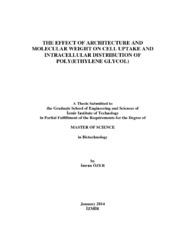Please use this identifier to cite or link to this item:
https://hdl.handle.net/11147/3674Full metadata record
| DC Field | Value | Language |
|---|---|---|
| dc.contributor.advisor | Bulmuş Zareie, Esma Volga | - |
| dc.contributor.author | Özer, İmran | - |
| dc.date.accessioned | 2014-07-22T13:52:06Z | - |
| dc.date.available | 2014-07-22T13:52:06Z | - |
| dc.date.issued | 2014 | - |
| dc.identifier.uri | http://hdl.handle.net/11147/3674 | - |
| dc.description | Thesis (Master)--Izmir Institute of Technology, Biotechnology, Izmir, 2014 | en_US |
| dc.description | Includes bibliographical references (laves: 60-66) | en_US |
| dc.description | Text in English; Abstract: Turkish and English | en_US |
| dc.description | xi, 74 leaves | en_US |
| dc.description | Full text release delayed at author's request until 2017.02.06 | en_US |
| dc.description.abstract | The aim of this thesis was to investigate interactions of comb-type poly(polyethylene glycol) methyl ether methacrylate (p(PEG-MA)) with in vitro cultured cells and compare to linear PEG counterparts. For this purpose, p(PEG-MA) polymers were at different molecular weights (10,000 g/mol (10K) and 20,000 g/mol (20K)) were synthesized via reversible addition fragmentation chain transfer (RAFT) polymerization. Characterizations of polymers were performed via NMR, GPC and DLS. The effects of polymers on in vitro cultured cells were investigated using cancerogenic A549 and healthy BEAS-2B human lung cell lines. Cytotoxicity of polymers was investigated via MTT assay. Comb-type p(PEG-MA) and linear PEG decreased the cell viability in a dose-dependent manner. However, the lowest cell viability was above 50% indicating no significant cytotoxic effect of both types of polymers. LDH assay was performed to determine the effect of polymers on cell membrane integrity. Both polymers enhanced membrane permeability in a dose- dependent manner. The highest LDH release was less than 2% indicating no significant effect on cell membrane integrity. Cellular uptake of both types of polymers completely diminished at 4oC suggesting energy-dependent internalization mechanism of polymers. Comb-type polymers were found to be taken up more by A549 cells. Comb-type polymers were internalized by A549 cells mainly via actin-dependent pathway, while BEAS-2B cells took up the all polymers via microtubule-dependent pathway. Linear 20K PEG was internalized by A549 cells via dominantly actin and also microtubule-dependent pathways while linear 10K PEG was taken up via actin-dependent pathway. Both comb-type and linear polymers were found to be localized in endocytic vesicles and cytosol. Consequently, comb-type PEG may offer an alternative to linear PEG with better cellular uptake properties and possess different uptake mechanisms in normal and cancer cells that may provide a potential for selective targeting strategies. | en_US |
| dc.language.iso | en | en_US |
| dc.publisher | Izmir Institute of Technology | en_US |
| dc.rights | info:eu-repo/semantics/openAccess | en_US |
| dc.subject.lcsh | Polyethylene glycol--Biotechnology | en |
| dc.title | The Effect of Architecture and Molecular Weight on Cell Uptake and Intracellular Distribution of Poly (ethylene Glycol) | en_US |
| dc.type | Master Thesis | en_US |
| dc.institutionauthor | Özer, İmran | - |
| dc.department | Thesis (Master)--İzmir Institute of Technology, Bioengineering | en_US |
| dc.relation.publicationcategory | Tez | en_US |
| dc.identifier.wosquality | N/A | - |
| dc.identifier.scopusquality | N/A | - |
| item.openairecristype | http://purl.org/coar/resource_type/c_18cf | - |
| item.cerifentitytype | Publications | - |
| item.fulltext | With Fulltext | - |
| item.languageiso639-1 | en | - |
| item.grantfulltext | open | - |
| item.openairetype | Master Thesis | - |
| Appears in Collections: | Master Degree / Yüksek Lisans Tezleri | |
Files in This Item:
| File | Description | Size | Format | |
|---|---|---|---|---|
| 10013053.pdf | MasterThesis | 1.73 MB | Adobe PDF |  View/Open |
CORE Recommender
Page view(s)
14,440
checked on May 5, 2025
Download(s)
132
checked on May 5, 2025
Google ScholarTM
Check
Items in GCRIS Repository are protected by copyright, with all rights reserved, unless otherwise indicated.